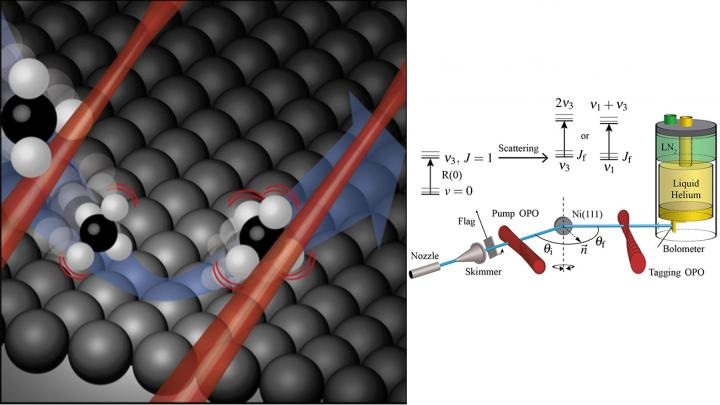Feb 5 2018
When molecules interact with solid surfaces, an entire range of diverse dynamic processes can occur. These are of huge interest in the context of catalytic reactions. For example, the conversion of natural gas into hydrogen, which can then be used to produce clean electricity.
 Illustration of methane scattering from a Ni(111) surface (left) and a diagram of the experimental setup used in this study (right). (Image credit: Rainer Beck/EPFL)
Illustration of methane scattering from a Ni(111) surface (left) and a diagram of the experimental setup used in this study (right). (Image credit: Rainer Beck/EPFL)
In particular, the interaction of methane molecules with catalyst surfaces, such as nickel, are of interest, to gain a comprehensive and meaningful insight of the process on a molecular level. But examining scattering dynamics of polyatomic molecules, such as methane, has been tough because existing detection methods are unable to resolve all the quantum states of the scattered molecules.
The lab of Rainer Beck at EPFL has currently used new infrared laser methods to examine methane scattering on a nickel surface for the first time with full quantum-state resolution. Quantum-state resolved methods have added a lot to scientists’ understanding of surface-scattering dynamics, but the novelty here was that the EPFL team was able to widen such studies to methane by integrating infrared lasers with a cryogenic bolometer - a very sensitive heat detector cooled to 1.8 K that can capture the kinetic and internal energy of the incoming methane molecules.
During their experiments, the robust infrared laser first pumps the incident methane molecules into a single selected, vibrationally excited quantum state. A second laser integrated with the bolometer is then used to examine the quantum state distribution of the scattered molecules. With this technique, the team observed, for the first time, a very efficient mechanism for vibrational energy redistribution during surface scattering.
The data from the research will allow advanced quantum theories for molecule/surface scattering to be examined strictly. Meanwhile, the new laser tagging method introduced in this research is extensively applicable and can be used to examine many other polyatomic molecule/surface systems with unparalleled detail.
The researchers received funding from Swiss National Science Foundation (SNSF).
Reference
Jörn Werdecker, Maarten E. van Reijzen, Bo-Jung Chen, Rainer D. Beck. Vibrational Energy Redistribution in a Gas-Surface Encounter: State-to-State Scattering of CH4 from Ni(111). Physical Review Letters 120, 053402 (2018), 31 January 2018. DOI: 10.1103/PhysRevLett.120.053402